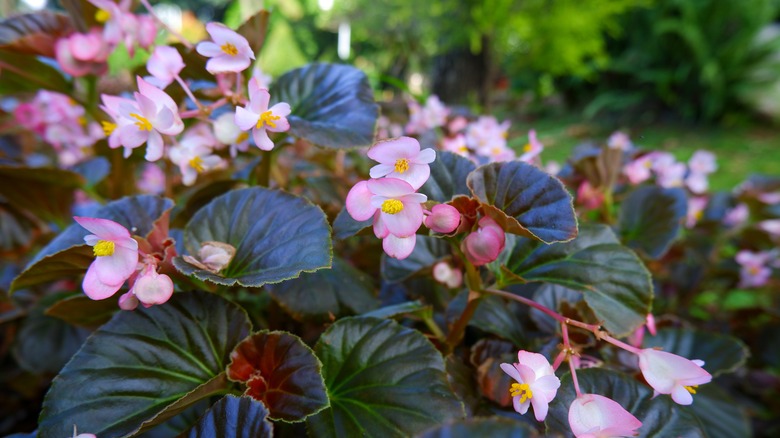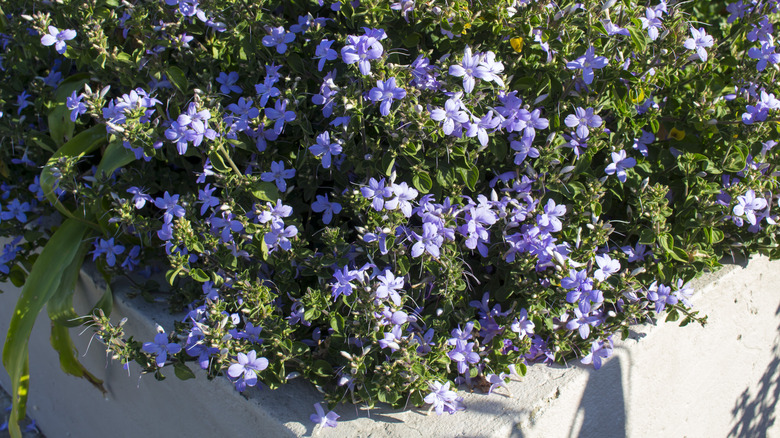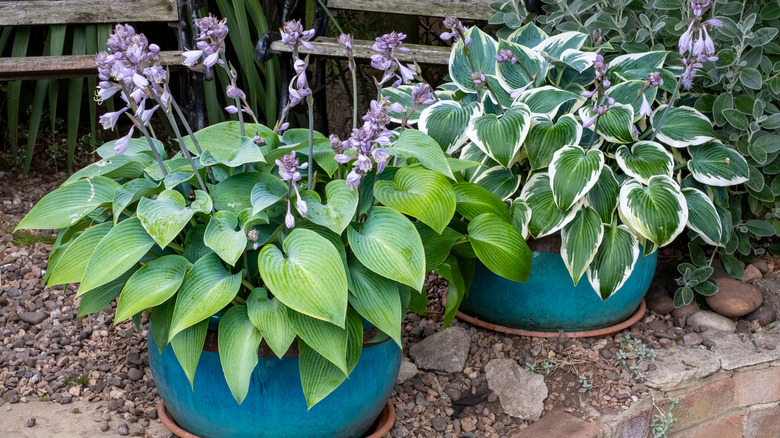15 Beautiful Plants That Will Thrive In Containers In The Shade
Plants, by definition, require light for the process of photosynthesis and their vitality. LAWN is the common acronym that explains plant needs: light, air, water, and nutrients. It can be a challenge to find and cultivate vegetation that tolerates low levels of light, let alone thrives in it to produce brightly colored flowers and rich greenery. According to the University of Minnesota, if a plan doesn't receive enough light, the leaves can go pale or yellow, and drop, variegated foliage may lose its spots or stripes, and flower buds might not form. The descriptions sticking out of containers at the nursery primarily list prime conditions as part or full-sun, and if your desired growing area is in the shade, shopping for plants can feel like no fun. However, there are many excellent options suitable for shadowed porches and dappled paths with various colors, flower types, leaf shapes, and growing habits. Here, we share 15 gorgeous plants that will flourish not only in a shady yard or garden spot but also in a pot; they often look even better together.
1. Begonia
Growing begonia (Begonia) is a sure way to have eye-catching flowers and showy greenery. Gardeningetc explains that it's a perfect plant for containers, is easy to care for, and offers long-lasting displays. A perennial in warmer regions yet generally treated as an annual, there are more than 1,800 varieties, many prized for their attractive, patterned leaves and clusters of blooms. Partial shade is just fine; water regularly and supplement weekly with a fertilizer. Begonias are mildly toxic to pets and can irritate if eaten, per Plant Addicts.
2. Jack Frost Brunnera
'Jack Frost' Brunnera (Brunnera macrophylla) has had the distinction of being named Perennial of the Year (via Wisconsin Horticulture). It is a more heat-tolerant cultivar of the plant known as Siberian bugloss, False Forget-Me-Not, and Heartleaf Brunnera. In addition to lovely foliage and delicate star-shaped, periwinkle flowers, it's deer and rabbit resistant. According to the outlet, 'Jack Frost' is complementary to heuchera, astilbe, and Japanese painted fern. Brunnera is low maintenance and prefers partial shade and moist, well-drained soil. Supplement with extra water during dry periods.
3. Elephant ear
A tropical native, caladium (Caladium bicolor) can thrive as an annual in a summertime climate. Outsized multi-colored leaves — called angel wings or elephant ears — add flair to a container as filler greenery or the star of the show and are one of the gardener's favorite shade-tolerant foliage plants. They prefer moist yet well-drained soil rich with organic matter, and filtered shade, where they will display better coloring. Per Garden Design, all parts of caladium are toxic if consumed.
4. Bush violet
Browallia (Browallia speciosa) is also known as amethyst flower and bush violet for its lush jewel-like blooms. However, flowers can also be white. Per Better Homes & Gardens, they are a hummingbird and pollinator magnet; plus, they don't require deadheading to present a continuous display. The dense foliage creates a mounded backdrop of green beneath blooms. Optimal growing conditions include part to full shade, regular watering, and soil amended with compost. Browallia is poisonous for dogs and cats if ingested, per North Carolina Extension Gardener.
5. Astilbe
Astilbe (Astilbe chinensis) provides color and texture via flower stalks that explode above darker leaves reminiscent of ferns, creating a dramatic show. Primarily a spring and summer bloomer, some varieties flower in the fall in pink, white, purple, or red clusters. This feathery plant is hardier than it looks; partial shade and rich, moist soil will keep it that way, with damp conditions preferred in summer heat per Almanac. Additionally, it's deer and rabbit resistant; however, butterflies find it immensely attractive.
6. Columbine
Columbine (Aquilegia vulgaris), or granny's bonnet, is ideal in areas that receive dappled shade. Thus, it's suitable to locate planted pots under a canopy of mature trees, for example. There are more than 70 species, with flowers ranging in color from pastels to brights, including pink, red, white, yellow, orange, purple, and blue. They attract hummingbirds and other pollinators. However, this perennial is deer resistant. Almanac suggests deadheading spent blooms and cautions against overwatering, noting the plant's drought tolerance. Columbine is toxic if ingested, per the University of Vermont Department of Plant and Soil Science.
7. Coral bells
Known as coral bells or alum root, heuchera (Heuchera sanguinea) is primarily an evergreen perennial lauded for its richly toned and resilient foliage. According to HGTV, color options for this plant include purple, burgundy, brown, silver, gold, and various greens. Leaves are adorned with flower-clustered spikes up to three times taller than the foliage, which blooms in late spring through summer. Heuchera demands a low-maintenance care regimen, preferring partial shade and moist, well-draining soil.
8. Hostas
Hostas (Hosta), also known as plantain lilies, are a favorite perennial among gardeners for their low maintenance and the dizzying range of available foliage. Assorted leaf shapes of various colors and patterns bloom with purple, blue, or white flower stalks. All About Gardening recommends ferns, coleus, begonia, browallia, or impatiens as desirable container companions. Per Southern Living, hostas thrive in shade and moist, well-drained soil enriched with organic matter. But beware, they are a snack of choice for deer, while toxic to cats and dogs if eaten, explains Maine Organic Farmers and Gardeners.
9. Spotted dead nettle
Lamium (Lamium maculatum), commonly called spotted dead nettle, is a quick-growing ground cover from the mint family that fills containers beautifully. It's a culinary herb with purported uses as an astringent. At the same time, the leaves have anti-bacterial and anti-inflammatory properties and can be applied topically to wounds, per Grow Forage Cook Ferment. Serrated and sometimes variegated leaves are topped with white, pink, or purple flower spikes. It grows most successfully in part to full shade and moist soil, per Gardening Channel.
10. Purple shamrock
Oxalis (Oxalis triangularis) is known by its common name, false or purple shamrock. The striking, dark purple leaves are showered with white blossoms most often in summer. According to Lazy Flora, the foliage moves toward the light; therefore, containers should be rotated to avoid uneven growth. For this perennial, the outlet suggests light shade and regular watering (when the top inch of soil is dry). All parts of the oxalis plant are toxic if consumed.
11. Wishbone flower
Touernia (Tourenia fournieri) is also known as bluewings or the wishbone flower. The low-growing annual possesses herbaceous foliage and attractive multi-colored flowers that bloom during summer and early fall. Tubular blossoms range from blue and purple to pink, yellow, and white. Though heat-tolerant, tourenia prefers afternoon shade and should be watered regularly to maintain moist conditions; it does well in soil amended with organic matter. GardenersHQ suggests pinching the tips back to produce a denser plant.
12. Ferns
There are more than 20,000 varieties of ferns (Polypodiopsida or Polypodiophyta), per Love to Know. Naturally occurring in woodlands, they prefer dappled shade and light, well-draining soil. The fronds are segmented into leaflets and appear in various shapes and tones of green, sometimes with a silvery or reddish blush. South Dakota State University explains that ferns produce spores but don't develop seeds, fruit, or flowers. They make an excellent backdrop for vegetation and an interesting contrast for rounded and oval foliage in a container garden. Spores of certain species can be toxic if ingested, according to Plant Addicts.
13. Hairy toad lily
The hairy toad lily (Tricyrtis hirta) is a perennial prized for its exotic, spotted flower heads resembling orchids and a later blooming in early autumn. The ornamental favors full shade and moist enriched soil. Wisconsin Horticulture suggests combining hairy toad lilies with ferns, hellebores, hostas, or any perennial that prefers a shaded and moist growing environment. As its name suggests, foliage and buds are covered in fine 'hairs,' making them unpalatable to deer. All parts of the plant are poisonous if ingested, per Dave's Garden.
14. Jewelweed
Jewelweed, or touch-me-not, is the popular annual also referred to as impatiens (Impatiens). It's a favorite shade option loved for its varied colors and vibrant addition to the landscape while requiring little maintenance. However, impatiens should be protected from the two most urgent challenges of browsing deer and downy mildew. It prefers partial shade and moist soil; according to HGTV, when it wilts, it's time to water, and it's a valuable signal when mixed with other plants which may not display their stress as readily.
15. Lenten rose
Hellebore (Helleborus ortientalis), commonly known as the Lenten or Christmas rose, is an evergreen, leathery-leafed perennial that rewards the gardener with blooms of numerous colors during winter and early spring. The stunning blossoms are an array of white, yellow, green, pink, purple, red, and black, playing subtle or vibrant shades upon a muted landscape. Hellebores prefer partial shade and moist, well-drained soil. They are deer resistant, and the leaves and roots are mildly poisonous; per North Carolina Extension Gardener, the origins of its name are derived from its toxicity.















